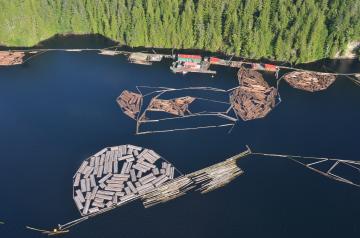A dozen years have passed since the Millennium Ecosystem Assessment popularized the concept of ecosystem services. In that time, the efforts of those working on natural capital and ecosystem services have shifted from debating the concepts to developing practical methods to incorporate their values into the decisions made at cabinet, council, boardrooms and kitchen tables. One recent model, led by the Municipal Natural Assets Initiative (MNAI), has focused on how to integrate consideration of natural capital into the major service delivery decisions made by local governments.
Failing infrastructure, rising service delivery costs, increasing climate change impacts and new accounting standards in Canada are all driving local governments to adopt modern asset management practices. This entails inventorying community assets (e.g. roads, pipes, treatment plants), determining their condition and value, and preparing and implementing asset management plans to maintain or replace them, with the goal of ensuring sustainable service delivery to a community. The emphasis on sustainable service delivery, not the individual asset that delivers the service, opens the door for managing what are being called “municipal natural assets” within this same system, and for investments in natural capital conservation, restoration, and management to be considered within the multi-million dollar envelopes traditionally reserved for engineered infrastructure.

The broader approach that MNAI supports is municipal natural asset management, which aims to incorporate natural assets into the traditional asset management planning and operations framework. This approach gives local governments tools to understand, manage and value natural assets in terms of the services they provide that are relevant to local government mandates– for example, flood management. It can also help local governments manage financial and environmental risk by better understanding the services that natural assets provide and the implications if those natural assets were lost. Its real value, however, is in helping local governments manage natural assets by using the same systematic management practices, and tapping the same budgets, to secure sustainable service delivery as engineered assets use. This framing enables a very direct and relevant conversation with engineering, public works, and finance departments on the importance of these natural assets to service delivery for local communities.
The promise of the approach lies in its attention to local government perspectives, powers and responsibilities, and above all, the use of asset management models with which local governments are increasingly familiar. The asset management connection is important for three reasons:
- First, the natural capital addressed is restricted to municipal natural assets, or “the stock of natural resources or ecosystems that contribute to the provision of services required for the health, well-being, and long-term sustainability of a community and its residents”, as defined by the MNAI.
- Second, the asset management platform narrows the scope to “only those municipal natural assets that would otherwise need to be provided via an engineered alternative by a municipality, regional government, or other form of local government to provide a service” (MNAI).
- Third, alternative scenarios for managing the natural asset (e.g. restoration, conservation, partial degradation, or full loss) are assessed along with replacement cost valuation, resulting in a pragmatic approach that allows a local government to directly compare the value provided by existing natural capital to the cost they would incur if those natural services needed to be replaced, in part or in full, through engineered infrastructure.
These elements allow the management of natural assets to be integrated directly into the core asset management and financial decision processes of local governments.
The pioneer of this approach, the on British Columbia’s west coast, found that understanding the importance of their natural assets for service delivery also shifted their paradigm for other key planning tools. They began by including natural assets in the Town’s overall asset management planning and financial framework, and identifying the importance of these natural assets in the notes section of their official Financial Report. Then, a specialized Eco-Asset Strategy was developed, and their Official Community Plan updated to include policies supporting natural asset conservation. Recently, they amended their development cost charge bylaw to support the rehabilitation of natural assets, and have applied to federal-provincial infrastructure programs for funds to protect and rehabilitate natural assets.
The promise? As a first cohort of Canadian communities pilot this municipal asset management approach, they are finding that it can be cheaper, at times by orders of magnitude, to protect nature through conservation and smarter urban design than to provide services such as stormwater management through engineered infrastructure—a highly attractive value proposition for this typically cash strapped order of government. Furthermore, they are discovering that natural assets are frequently resilient and adaptable to the impacts of climate change. This means that with effective monitoring, maintenance and rehabilitation now, natural assets will provide service and add value for decades to come in a way that many engineered assets simply cannot match.
For more information on the Municipal Natural Assets Initiative, visit the website: http://institute.smartprosperity.ca/content/municipal-natural-assets-initiative and our Facebook page https://www.facebook.com/municipalnaturalassets

